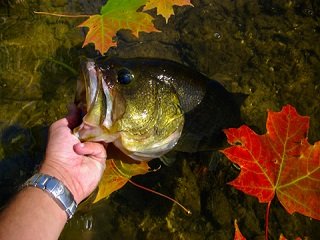 When it comes to getting strikes, there are dozens of lures that appeal to the aggressive, predatory instincts of fish. However, what about when they’re not active? This happens when changes in temperature or weather, or pressure from an over-abundance of anglers cause fish to be a little more hesitant. Knowing how to trigger reaction strikes will come in handy in this situation, and today I’ve provided you with a few hints on how to do this effectively!
When it comes to getting strikes, there are dozens of lures that appeal to the aggressive, predatory instincts of fish. However, what about when they’re not active? This happens when changes in temperature or weather, or pressure from an over-abundance of anglers cause fish to be a little more hesitant. Knowing how to trigger reaction strikes will come in handy in this situation, and today I’ve provided you with a few hints on how to do this effectively!
By nature, bass are predators and will react to anything that pushes that button. Hiding in a bush, a weed patch, or against rocks and logs, bass are in ambush mode, and are focused on attacking anything that comes near, be it a crawfish, shad, bluegill or shiner. You can take advantage of this by dropping a lure right on their nose. Other lures can and will work in this situation at times, but using the element of surprise instead of blindly casting a lure will yield more strikes.
You can trigger a reaction bite with a variety of baits and techniques. Flipping a jig or worm into heavy cover, ripping a spinnerbait over weeds or through brush tops, banging crankbaits into rocks or stumps, or sputtering a topwater or buzzbait over shallow cover will produce time and time again. You want the initial cast to land right on the fish’s nose, if possible, and with experience, you can anticipate where that will be. For example, if you flip to a log and a fish swims away when the line and lure hit the water, try to make a mental note of where that fish was on the log and take that into consideration on the next one.
One thing to remember is that you have to be sneaky to catch fish. One of the biggest mistakes anglers make is alerting the bass to their presence. To trigger reaction strikes, you must keep the fish at ease, which can be done by using the trolling motor quietly, being wary of the shadows you may be casting over a target, and making subtle presentations. This is really critical in shallow water, especially if the water is clear. Also, before moving into a potential area, take a moment to consider the least noticeable direction from which to attack and assess where you think the fish may be sitting up on the cover. If the water is shallow, adjust your trolling motor shaft so the prop doesn’t churn mud or sputter on the surface and make a lot of noise that might scare the fish.
You can appeal to a bass’s predatory nature with lures and tactics that are designed to do just that, you will catch more fish—even when they aren’t biting. When the weather or over-fishing takes its toll and fish just aren’t as active as you would like, employ a few of the tips outlined above and you’ll see great results in no time!








